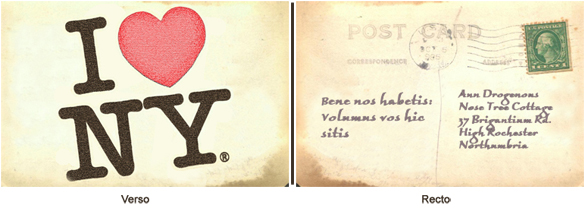 |
|
|
|
From 9th October 1985
After the meeting of Mr Watha and sober old Abbot Ginn of the Rocks the Indians and the Monks became quite friendly, and life in the infant colony settled down to its usual calm and quiet pace. Since this was rather boring, Neatanniel soon became bored and decided to liven things up a bit. The monks had brought some pigeons with them from Britain to cook into what the abbot jokingly liked to call “pie in the sky”: two of these poor birds were still lingering about, and Neatanniel, remembering their propensity for going home, decided to get things going by sending a message home.
The actual message, which arrived in England, at High Rochester in the Cheviots, on the 12th October 985, has survived. On one side it has a crude and inexplicable drawing - what appears to be the Roman numeral I, followed by what looks like a heart and what is indisputably the letters “N” & “Y” (presumably the Welsh name Nye).

This message has long puzzled historians and, in the two hundred years since its discovery behind some unused whiskey bottles in the public bar of the Dog and Ocelot Inn in Llandudno by Professor Llaregub Thomas of the University of Bangor, it has given rise to a plethora of more or less hysterical “Welsh Connection” theories. I’m sure we shall never know what “1 heart for Nye” really means---if it's a love letter, a plea for organ donors or merely an advertising slogan, and anyway perhaps is better that we don’t know because in some ways I think an exciting mystery is a greater inspiration than some no doubt prosaic truth. On the other side of the card is a much clearer message. It is a plaintive plea for colonists, touching in its heartfelt simplicity even after ten centuries. In translation it reads “Having a wonderful time, wish you were here”. A year to the day later, on the 12th October 986 A.D. the first boatload of English colonists arrived.
The joy of their arrival was so great that one of the new arrivals, a certain Miss Drogenous, was overcome by visions after meditating all afternoon with Abbot Ginn. In one of these visions she saw a miraculous column of shimmering sculpted portraits of the founding brothers and Neatanniel, and so it was that Ann Drogenous came up with a way to commemorate Rochester’s founders. This Mediæval Mount Rushmore was called the Column of Busts. It is interesting to note that, as many scholars have maintained, we see in this column of busts the origin of the Totem pole, one of the many ideas that the Indians pinched from the early Rochesterians. We can, of course, at last with propriety call our settlers Rochesterians with some justification, because one of the things that the newcomers brought with them was the name of their little village in England. Though, come to think of it, if we want historical justification we should call them Hrofæscæstrians.
But whatever we call them from that time on the Rochesterians have always celebrated the founders of their jolly city on 12th October, and it is one of the strongest bits of circumstantial evidence for the continuous habitation of our site that even this year on 12th October a millennium later we will be celebrating Column-Bust day!
Cheerio for now
from Richard Howland-Bolton.
 |  |
<-- Go Back |
|
|
| |

